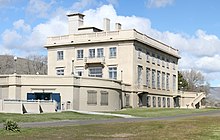Maryhill Museum of Art
 |
|
| Established | 1940 |
|---|---|
| Location | near Maryhill, Washington |
| Website | |
|
Maryhill
|
|
| Nearest city | Goldendale, Washington |
| Coordinates | 45°40′40″N 120°51′48″W / 45.67778°N 120.86333°W |
| Area | 34 acres (13.8 ha) |
| Built | 1914 |
| Architect | Hornblower & Marshall |
| Architectural style | Beaux-Arts |
| NRHP Reference # | |
| Added to NRHP | December 31, 1974 |
Maryhill Museum of Art is a small museum with an eclectic collection, located near what is now the community of Maryhill in the U.S. state of Washington.
The museum is situated on a bluff overlooking the eastern end of the Columbia River Gorge. The structure was originally intended as a mansion for entrepreneur Samuel Hill (1857-1931), and was designed by architects Hornblower and Marshall. It was named Maryhill for Hill's wife, daughter of James J. Hill, a Great Northern Railroad baron, and was intended to be used as a home at which they could entertain Samuel Hill's school friend King Albert I of Belgium. Construction was halted upon America's entry into World War I. The unfinished museum building was dedicated on November 3, 1926 by Queen Marie of Romania, and was opened to the public on Hill's birthday (May 13) in 1940. The museum's first physical expansion was completed when the Mary and Bruce Stevenson Wing opened to the public in May 2012. It includes a plaza that overlooks the Columbia River, an education center, a collections suite and a café.
Notable in the Maryhill Museum collection are:
The Maryhill Museum building was designed as a private residence for Sam Hill by Washington, D.C., architects Hornblower & Marshall. It was designed in a Beaux-Arts style and built of steel-reinforced concrete beginning in 1914. Hill imagined the structure as a ranch building amidst a 5,300-acre agricultural community that he was developing at the eastern end of the Columbia River Gorge. During a 1917 visit by his friend Loïe Fuller, he decided to turn his unfinished home into “a museum for the public good, and for the betterment of French art in the far Northwest of America.” Hill’s contribution to the new museum included almost 90 American Indian baskets, more than 70 Rodin sculptures and watercolors, and many personal items.
...
Wikipedia

